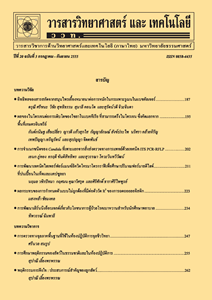การประเมินผลกระทบจากการเผาชีวมวลต่อระดับฝุ่นละอองขนาดเล็กกว่า 10 ไมครอน (PM10) ในช่วงที่มีปัญหาหมอกควันในพื้นที่ประเทศไทยโดยใช้แบบจำลอง WRF-CMAQ
Main Article Content
บทคัดย่อ
บทคัดย่อ
การเผาชีวมวลเป็นแหล่งกำเนิดสำคัญของ PM10 ในประเทศไทย ระดับ PM10 ที่สูงผิดปกติจากค่าการตรวจวัดมักพบในช่วงฤดูร้อน ระบบแบบจำลอง WRF-CMAQ (weather research and forecasting, WRF) และ community multiscale air quality, CMAQ) นำมาใช้ในการประเมินผลกระทบของการเผาในที่โล่งต่อ PM10 ในช่วงที่มีปัญหาหมอกควันรุนแรงในเดือนมีนาคม พ.ศ. 2555 ผลจากการวิจัยพบว่าการเผาชีวมวลมีผลกระทบต่อความเข้มข้น PM10 ในบรรยากาศ 72 % โดยภาพรวมทั้งประเทศ โดยเฉพาะอย่างยิ่งในภาคเหนือของประเทศไทยได้รับผลกระทบสูงสุดถึง 94 % ในขณะที่ภูมิภาคอื่นของประเทศได้รับผลกระทบอยู่ในช่วง 56-78 % จากผลการวิจัยสรุปได้ว่าการเผาในที่โล่งเป็นแหล่งกำเนิดหลักของ PM10 ในช่วงฤดูร้อนของประเทศไทย ดังนั้นการจัดการคุณภาพอากาศควรเน้นที่แหล่งกำเนิดการเผาชีวมวลทั้งในพื้นที่ประเทศไทยและประเทศข้างเคียง
คำสำคัญ : การเผาในที่โล่ง; การประเมินผลกระทบมลพิษอากาศ; ภาคเหนือของประเทศไทย; PM10; WRF-CMAQ
Article Details
References
[2] Hao, W.M. and Liu, M.H., 1994, Spatial and temporal distribution of tropical biomass burning, Global Biogeochem. Cycles 8: 495-503.
[3] Reid Jeffrey S., Hyer, E., Johnson, R., Holben, B.N., Yokelson, R., et al., 2013, Observing and understanding the Southeast Asian aerosol system by remote sensing: An initial review and analysis for the Seven Southeast Asian Studies (7SEAS) program, Atmospheric Res. 122: 403-468.
[4] วิจารย์ สิมาฉายา, 2554, มลพิษจากหมอกควันในพื้นที่ภาคเหนือ : ปัญหาและแนวทาง, แหล่งที่ มา : http://www.pcd.go.th/info_serv/air_ thaihaze.html#h4, มีนาคม 2560.
[5] Fowler, C.T., 2003, Human health impacts of forest fires in the Southern United States: A literature review, J. Ecol. Anthropol. 7: 39-63.
[6] สิทธิชัย พิมลศรี และภวัต อารินทร์, 2553, สถานการณ์ปัญหาฝุ่นละอองในบรรยากาศและผลกระทบต่อสุขภาพประชาชนในจังหวัดลำปาง, นเรศวรวิจัย ครั้งที่ 6, มหาวิทยาลัยนเรศวร, พิษณุโลก.
[7] Kanabkaew, T. and Kim Oanh, N.T., 2011, Development of spatial and temporal emission inventory for crop residue field burning, Environ. Model. Assess. 16: 453-464.
[8] Gadde, B., Bonneta, S., Menkeb, C. and Garivaita, S., 2009, Air pollutant emissions from rice straw open field burning in India, Thailand and the Philippines, Environ. Pollut. 157: 1554-1558.
[9] Cheewaphongphan, P. and Garivait, S., 2013, Bottom up approach to estimate air pollution of rice residue open burning in Thailand, Asia-Pacific J. Atmosph. Sci. 49: 139-149.
[10] Junpen, A., Garivait, S. and Bonnet, S., 2013, Estimating emissions from forest fires in Thailand using MODIS active fire product and country specific data, Asia-Pacific J. Atmosph. Sci. 49: 389-400.
[11] Tsai, Y.I., Sopajareec, K., Chotruksa, A., Wu, H.C. and Kuo, S.C., 2013, Source indicators of biomass burning associated with inorganic salts and carboxylates in dry season ambient aerosol in Chiang Mai Basin, Thailand, Atmosph. Environ. 78: 93-104.
[12] Chantara, S., Sillapapiromsuk, S. and Wiriya, W., 2012, Atmospheric pollutants in Chiang Mai (Thailand) over a five-year period (2005-2009), their possible sources and relation to air mass movement, Atmosph. Environ. 60: 88-98.
[13] Kim Oanh, N.T. and Leelasakultum, K., 2011, Analysis of meteorology and emission in haze episode prevalence over mountain-bounded region for early warning, Sci. Total Environ. 409: 2261-2271.
[14] เกษมสันต์ มโนมัยพิบูลย์, 2552, การพัฒนาระบบแบบจำลองทางคณิตศาสตร์เบื้องต้นเพื่อให้ในงานพยากรณ์เตือนภัยมลภาวะหมอกควันสำหรับภาคเหนือตอนบนของประเทศไทยและการประยุกต์ใช้ในฤดูไฟป่าหน้าแล้ง, แหล่งที่มา : http://www.aqnis.pcd.go.th/project/northernhaze2551, มีนาคม 2560.
[15] วาฑิต วทัญญูไพศาล และนริศรา ทองบุญชู, 2552, แบบจําลองแบบบูรณาการเพื่อใช้ในการศึกษาความเป็นไปของมลพิษทางอากาศจากไฟป่าในภูมิภาคเอเชียตะวันออกเฉียงใต้, วิศวสารลาดกระบัง 26(2): 31-37.
[16] Teerachai, A. and Jiemjai, K., 2012, Investigation of fine and coarse particulate matter from burning areas in Chiang Mai, Thailand using the WRF/ CALPUFF, J. Sci. Fac. Chiang Mai Univ. 39: 311-326.
[17] Byun, D.W. and Ching, J.K.S., 1999, Science algorithms of the EPA Models-3 Community Multiscale Air Quality (CMAQ), U.S. Environmental Protection Agency, Washington, D.C.: EPA/600/R-99/030 (NTIS
PB2000-100561).
[18]. Wang, L., Hao, J., He, K., Wang, S., Li, J., Zhang, O., Streets, D.G., Fu, J.S., Jang, C.J., Takekawa, H. and Chatani, S., 2008, A modeling study of coarse particulate matter pollution in Beijing: regional source contributions and control implications for the 2008 Summer Olympics, J. Air Waste Manag. Assoc. 58: 1057-1069.
[19] Huang, K., Fu, J.S., Hsu, C.N., Gao, Y., Dong, X., Tsay, S.C. and Lam, Y.F., 2013, Impact assessment of biomass burning on air quality in Southeast and East Asia during BASE-ASIA, Atmosph. Environ. 78: 291-302.
[20] Cheng, Z., Wang, S., Fu, X., Watson, J.G., Jiang, J., Fu, Q., Chen, C., Xu, B., Yu, J., Chow, J.C. and Hao, J., 2014, Impact of biomass burning on haze pollution in the Yangtze River delta, China: a case study in summer 2011, Atmos. Chem. Phys 14: 4573-4585.
[21] Skamarock, W.C., Klemp, J.B., Dudhia, J., Gill, D.O., Barker, D.M., Duda, M.G., Huang, X.Y., Wang, W. and Powers, J.G., 2008, A Description of the Advanced Research WRF Version 3. NCAR Technical Note NCAR/TN-475+STR, B. NCAR, CO, USA.
[22] Lu, Z. and Streets, D.G., The Southeast Asia Composition, Cloud, Climate Coupling Regional Study Emission Inventory, Available Source: http://bio. cgrer.uiowa.edu/SEAC4RS/html, March 2016.
[23] Andela, N., Kaiser, J.W., Heil, A., van Leeuwen, T.T., van der Werf, G.R., Wooster, M.J., Remy, S. and Schultz, M., 2013, Assessment of the Global Fire Assimilation System (GFASv1), JuSER, April: 1-75, FZJ-2015-00718.
[24] Shi, Y., Matsunaga, T., Saito, M., Yamaguchi, Y. and Chen, X., 2015, Comparison of global inventories of CO2 emissions from biomass burning during 2002-2011 derived from multiple satellite products, Environ. Pollut. 206: 479-487.
[25] Chuang, M.T., Fu, J.S., Lin, N.H., Lee, C.T. and Gao, Y., et al., 2015, Simulating the transport and chemical evolution of biomass burning pollutants originating from Southeast Asia during 7-SEAS/2010 Dongsha experiment, Atmosph. Environ. 112: 294-305.
[26] Fu, J.S., Hsu, N.C., Gao, Y., Huang, K., Li, C., Lin, N.H. and Tsay, S.C., 2012, Evaluating the influences of biomass burning during 2006 BASE-ASIA: A regional chemical transport modeling, Atmos. Chem. Phys 12: 3837-3855.
[27] Vongruang, P., Wongwises, P. and Pimonsree, S., 2017, Assessment of fire emission inventories for simulating particulate matter in Upper Southeast Asia using WRF-CMAQ, Atmosph. Pollut. Res. (in press).

